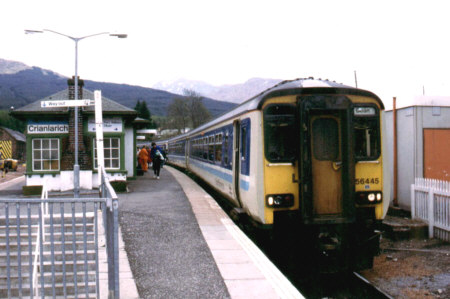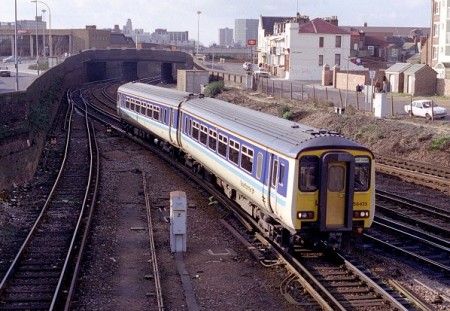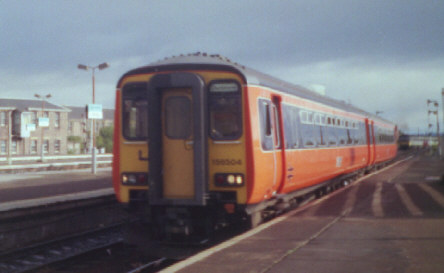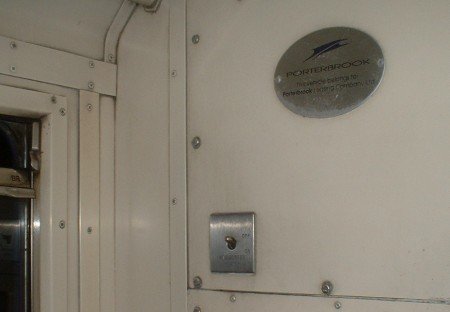The British Rail Years - 156 Super-Sprinter
156 » Class Origins • British Rail Years • Depot Allocations • Misformed Sets • Naming Details • Accidents • Time-Line
The British Rail Years - 156 Super-Sprinter |
|
156 » Class Origins • British Rail Years • Depot Allocations • Misformed Sets • Naming Details • Accidents • Time-Line | |
 | Haymarket based 156.445 at Crianlarich on the West Highland Line. 1991. This is one of several routes operated with RETB signalling. Photo: John Law |
The first units were delivered to Norwich depot, where they launched a new regular 'Express' service from East Anglia to the East Midlands and the North West in May 1988. Further deliveries saw the East Anglia to Birmingham route operated with Super-Sprinters by July.
In Scotland, the units directly replaced loco-hauled trains on the Glasgow to Stranraer and Carlisle via Dumfries routes in October 1988 and the West Highland lines in January 1989.
Inverness depot received units to replace loco-hauled trains on the lines to Aberdeen, Kyle of Lochalsh, and the Far North Line to Wick and Thurso.
Despite a viaduct collapsing at Inverness in February 1989, and isolating the lines to the north, five Super Sprinters were moved by lorry to work the Far North Line from April. They were maintained at a temporary depot at Muir of Ord until the replacement bridge was reopened in May 1990.
In Scotland, the mostly rural services on which they were used were marketed as "ScotRail Super Sprinter" services.
Leyland Super-Sprinters Withdrawn
 |
Less than one month old, 156473 is seen running empty into Fratton Depot from Portsmouth Harbour, on 12 February,1989. Photo: K. P. Squire |
In December 1988, the Leyland built class 155 fleet based at Cardiff was temporarily withdrawn from passenger service and class 156 units recently delivered to Scottish depots were drafted in as replacements. From January 1989 new units were delivered direct to Cardiff, allowing earlier units to return to Scotland.
During 1989 class 156's were regular performers on the Cardiff to Portsmouth/Brighton route.
The Leyland units started to return to service from May 1989, allowing the class 156s to be reallocated, but it was not until November that the last Metro-Cammell unit left Cardiff.
Later units were delivered to Neville Hill, where they replaced the unsuitable class 150 units on Trans-Pennine Express services from Hull and Scarborough to Manchester and Liverpool.
The Strathclyde Passenger Transport Executive funded 14 units to replace 30 year old DMUs on its supported services from Glasgow Queen Street to Cumbernauld, Glasgow Central to East Kilbride, Barrhead and Kilmarnock. These were delivered in Strathclyde Transport orange and black livery, and entered service from August 1989.
 | Strathclyde Transport liveried 156.504 arrives at Stirling with a Glasgow Queen St to Dunblane service, 7 October 1989. |
The late delivery of Class 158 'Express' units gave problems to ScotRail in May 1990 as its push-pull rolling stock was transferred away to InterCity. This was compounded as the frequency of the Glasgow to Aberdeen route was to be doubled to an hourly service. To keep the Edinburgh - Glasgow timetable operating, the line from Inverness to Aberdeen reverted to loco-hauled trains, and seven Inverness class 156s were transferred to Haymarket, joined by eleven other units from Norwich and Neville Hill. The class 158's eventually entered service in September and by the start of the Winter timetable enough had been accepted to allow the borrowed Super-Sprinters to be returned.
As more class 158 'Express' units were introduced, Super Sprinters were replaced on the Trans-Pennine, Inverness - Aberdeen, Anglia - Midlands - North West routes, and units were tranferred to other depots; Etches Park (Derby), Tyseley (Birmingham), Newton Heath (Manchester) and Heaton (Newcastle).
The belated introduction of 158's initiated a cascade of rolling stock that saw Super Sprinters taking over secondary routes which had previously been operated by class 150 units, such as Coventry - Lincoln, Blackpool - Manchester, Hereford - Oxford, the Cambrian coast line and services in North Wales.
 | After being displaced from Express duties to Liverpool and Birmingham, Norwich Crown Point Depot retained a small fleet of 156s for use on local services in East Anglia. On October 21 1993, 156.405 became the first Sprinter to pass 1 million miles, whilst working 10:10 Great Yarmouth - Norwich Service. Photo: Paul Stanforth |
Under the restructuring of British Rail in 1994, the divisions of Regional Railways became Train Operating Companies in preparation for franchising. Regional Railways Central lost responsibility for East Anglia local services and was renamed Central Trains (although it continued to use the Regional Railways name).
Ownership of British Rail's passenger rolling stock was transferred to three newly created leasing companies on April 1, 1994. The class 156 fleet was split between Porterbrook (38 units) and Angel Trains (76 units). These companies were sold to the private sector in January 1996.
The franchising of the Train Operating Companies was completed in the first months of 1997. RR North West was won by Great Western Holdings, and renamed North Western Trains. Central Trains went to National Express, RR North East was won by MTL and later renamed Northern Spirit. Finally National Express took over ScotRail, on 1st April 1997, the last TOC to be franchised.

| 'This vehicle belongs to Photo: 'Vavavoom' |